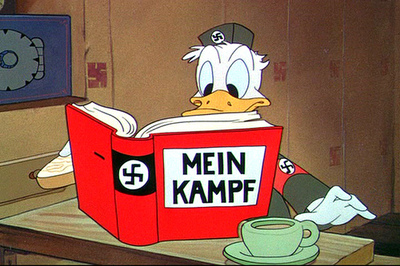
“With all the attention I got, it looked as though the army’s plan was for me to win the war single-handed.”

Re-printed with permission from WartimeNI.com
PRIVATE FIRST CLASS Milburn H. Henke served in the U.S. Army during the Second World War. Part of Company B, 1st Battalion, 133rd Infantry Regiment, 34th Infantry Division “the Red Bulls,” he would go down in history as the first American GI to set foot on European soil in the Second World War.
Born on Aug. 24, 1918, he was the son of Carl Henke and Louise Henke, a farming family from McLeod County, Minnesota. The family moved to Hutchinson, Minnesota in 1921. As a young man, Milburn enjoyed baseball, reading, hunting, and fishing. He worked for his father at Henke’s Café in Hutchinson.
He enlisted on Sept. 21, 1940 to beat the draft. On Oct. 10, 1941, Henke’s 135th Regiment merged with the Iowa National Guard 133rd Regiment. In a little over a month after the attack at Pearl Harbor, the men of the outfit were bound for the European Theatre of Operations.
U.S. Army arrival in Belfast
Henke’s troopship landed ashore at Dufferin Dock, Belfast on Jan. 26, 1942 – the first Americans to arrive in the British Isles as part of the build-up in preparation for the eventual liberation of the continent.
He descended the gangplank from a British tender that had brought soldiers to the docks from the converted liner HMTS Strathaird. In truth, around 500 American personnel had already disembarked; Henke would be put forward as the face of the landing. Henke repeated the famous step six times enabling photographers to get the perfect photo.
GIs formed along the docks from USS Chateau Thierry, the Strathaird, the Canterbury, the Princess Maud, the Maid of New Orleans, and the Royal Daffodil. These men had been at sea since departing from Brooklyn, New York on Jan. 15, 1942.
Henke was with his company when a Colonel asked for a volunteer. Henke’s Lieutenant put his name forward and the Private expected he was going ashore to unload equipment.

“I was sitting on some barracks bags, and this colonel came up the gangplank, and there were about fifteen of us,” Henke would later recall. “There was a lieutenant there and he said: ‘I want a man from Company B, 133rd,’ and Lieutenant Springer, he turned around: ‘Henke, you go with him.’ When I got by the gangplank, General Hartle came to meet me. He said, ‘Do you think you can talk over a radio?’ And I said, ‘Well, if I have to, I think I can.’”
Henke met with Major General Russell P. Hartle, commanding officer of 34th Infantry Division. There was some surprise when Hartle discovered the ceremonial first soldier to go ashore was from Minnesota rather than his home state of Iowa. Yet Henke had the look of a typical United States doughboy, with an easygoing nature and good looks. The irony that the first American GI in Europe had a German surname was conveniently overlooked.
Atlantic Crossings Make History
An official welcoming ceremony took place after the band of the Royal Ulster Rifles played “the Star-Spangled Banner.” Sir Archibald Sinclair – Secretary of State for Air, the Duke of Abercorn – Governor of Northern Ireland, and John Andrews – Prime Minister of Northern Ireland welcomed the American private. Like the other GIs of the first contingent of MAGNET Force, the operation aimed at building up a U.S. military presence in Northern Ireland, Henke sported a First World War-era M1917 Brodie helmet. The U.S. at that point had only just started to issue the iconic M1 “steel pot” design. He carried a M1903 Springfield rifle on his back and wore a military jacket and tie.
He spoke with British, Irish, and American reporters giving radio interviews. His name and face were soon all over the national news back home. The press focussed on the love story between Milburn and his girlfriend Iola Christensen of Minnesota. She also gave a radio interview broadcast in Britain and America in which she swore to wait for his return. Radio stations also staged a telephone call between Henke and his parents in America. While he seemed to enjoy the celebrity status, reports suggest his fame may have contributed to the rejection of his request to join the U.S. Rangers.
“With all the attention I got, it looked as though the Army’s plan was for me to win the war single-handed,” Henke joked.
Henke took part in the November, 1942 invasion of North Africa, dubbed Operation Torch and later won the Silver Star after charging through enemy fire to rescue a wounded officer. While preparing for the Allied landings in Italy in 1943, Henke suffered a serious back injury unloading heavy equipment from a vehicle. Following months of recovery in hospital, he returned to the United States on leave. He married Christensen shortly after his return and spent the rest of the war stateside.
In 1992, Henke returned to Ireland to commemorate the 50th anniversary of his arrival.











1 thought on “Meet Milburn H. Henke, the ‘First’ American GI to Land in Europe in World War Two”